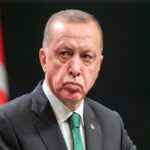Turkey is undergoing extensive upgrades of its fleet of F-16 fighter jets, its air force’s backbone. Such efforts are undoubtedly essential because Ankara is unlikely to procure any fifth-generation replacements for a long time to come.
The head of Turkey’s Presidency of Defense Industries, SSB, Ismail Demir, recently confirmed that Turkey is making structural improvements to improve the lifespan of the oldest F-16s in its fleet, the Block 30 fighters it first began receiving in the late 1980s from the United States.
Demir tweeted that these structural upgrades will substantially extend the life of its these jets from 8,000 flight hours to 12,000. He also said that the project will include “the renovation and revision of 1,200 to 1,500 structural parts per aircraft.”
The Turkish Air Force possesses well over 200 F-16s, from those aged Block 30 versions to the more modern Block 50s. It’s the third-largest operator of F-16s on the planet behind only the United States and Israel and one of only five countries aside from the U.S. that locally manufactures that iconic fighter jet.
However, sheer necessity and severe procurement shortcomings could see Turkey left with little choice but to maintain these fighter jets for much longer than planned.
The Turkish Air Force had previously sought up to 100 stealthy fifth-generation F-35A Lightning II jet fighters from the United States. These were expected to replace its fleet of aging F-4E Phantom II jets and, probably eventually, some of those older Block 30 F-16s it is upgrading today.
Unfortunately for Turkey, it was suspended from the F-35 Joint Strike Fighter program in 2019 by the U.S. for its controversial purchase of advanced Russian S-400 air defense missile systems. Its air force order was also canceled. More recently, the United States slapped sanctions on the SSB, along with “visa restrictions” on Demir himself, in December 2020 over that procurement.
The U.S. Congress has also been freezing arms sales to Turkey since mid-2018, which are believed to include U.S. assistance in the structural upgrades of Turkish F-16s. Also, the latest sanctions coupled with that undeclared arms freeze more likely than not mean that Turkey cannot expect the U.S. to help it upgrade many of its F-16s to the latest F-16 Block 70/72 Viper configuration, which Lockheed Martin LMT 0.0% LMT 0.0% is presently doing for most of Greece’s F-16 fleet.
Of course, none of this means that Turkey’s F-16s will become grounded or completely obsolete anytime soon. As Turkish journalist Burak Bekdil recently noted: “Turkish Aerospace Industries can provide the F-16s with structural upgrades, Turkish Engine Industries can offer solutions for engine maintenance and repairs, and military electronics specialist Aselsan can modernize avionics when required.”
In other words, even with a U.S. freeze or outright embargo on maintenance and technical assistance, something Ankara likely anticipated before taking delivery of S-400s since it reportedly stockpiled spare F-16 parts, Turkey’s F-16s will remain highly formidable fourth-generation aircraft for years to come. But even then, time will inevitably take its toll. Bekdil forecasts that most of this fleet, particularly those older Block 30s, will need to be phased out in the next 10-15 years.
In the meantime, Turkey has few options for procuring fifth-generation aircraft from other sources. Buying Russian Su-57s would further antagonize the U.S. and NATO. Anyway, that plane is unlikely to be exported in significant numbers for many years to come. Furthermore, Turkey’s domestic fifth-generation fighter project, the TF-X, is also not expected to be fully developed in this decade.
Consequently, Ankara’s options for a fifth-generation fighter jet are, at the very least, severely constrained for the foreseeable future.
Perhaps the Turkish Air Force will slowly begin loosely resembling that of its neighbor Iran’s in some ways.
In the 1970s, under the rule of the last Shah, Iran acquired an enormous and highly sophisticated fleet of fighter jets, among other advanced weapons systems, that was only rivaled by that of Israel in the region at that time. The fleet consisted of highly advanced fourth-generation F-14 Tomcats, undoubtedly the deadliest air superiority fighter jet in the world at the time, along with large numbers of F-4s and F-5 Tiger IIs.

The Shah also ordered 160 F-16s and expressed interest in buying 140 more. They would likely have gradually replaced Iran’s F-4s and F-5s between the 1980s and early 2000s. That’s if, of course, the 1979 revolution and the subsequent collapse of hitherto close U.S.-Iran relations hadn’t transpired.
Ultimately not a single F-16 was ever delivered to Iran.
Under an arms embargo, Iran still managed to keep a substantial number of its 79, out of 80 ordered before the revolution, F-14s, all of which were the original A models, airborne despite their chronically unreliable TF30 engines. This was impressive considering the Islamic Republic did not inherit any substantial capability to locally manufacture spare parts for these cutting-edge aircraft. On the other hand, Turkey, as alluded to above, acquired the ability to locally manufacture F-16s and their various parts after it started procuring those fourth-generation jets in 1987.
Nevertheless, Tehran made do, even resorting to cannibalizing some grounded F-14 airframes for spare parts to keep frontline fighters airworthy when necessary. One very telling statistic in military aviation expert Tom Cooper’s essential book on these fighter jets was that during the Iran-Iraq War, each Iranian Tomcat needed an average 400 hours of maintenance for every hour of flight!
In the 1970s many Americans expressed worries that pre-revolutionary Iran was so heavily dependent on U.S. technical assistance for maintaining its air force that Washington could end up unwittingly becoming dragged into a war. Iran ultimately proved these widespread assessments incorrect by keeping many of its F-14s operational in the face of repeated U.S. efforts over the years to ground them.
Today, over 40 years after the Shah’s procurement, Iran still has F-14s serving in its air force. They have undergone numerous maintenance overhauls, modifications, and upgrades over the years. Perhaps going into the 2030s, many of Turkey’s present-day Block 50 F-16s will also still be in frontline service outfitted with more locally-built Turkish components and weapons systems.
Aside from Turkey, Iran remains the only country in the wider Middle East that still operates F-4s. With the prospect of acquiring that vast Iranian F-16 fleet long past, Tehran simply had to keep these increasingly aged fighters in service out of necessity. Turkey’s much more recently lost opportunity for acquiring F-35s, coupled with the distant dream of developing a fully functional TF-X, means that it too will likely have to prolong the service life of its remaining F-4s much longer than intended.
While Iran procured a sizable fleet of Russian fourth-generation MiG-29 Fulcrums in the 1990s, much of its air force inventory to this day still largely consists of leftovers from the Shah’s acquisitions. Similarly, while Turkey might eventually risk buying 4.5-generation Su-35 multirole fighters from Russia, especially if defense ties with the U.S. and the West are further or irreparably strained, these too would more likely supplement rather than fully replace its F-16 fleet.
By: Paul Iddon
Follow me on Twitter. Paul Iddon
I am a journalist/columnist who writes about Middle East military and political affairs.
Source: Forbes



